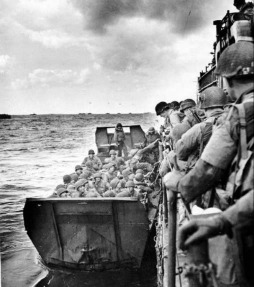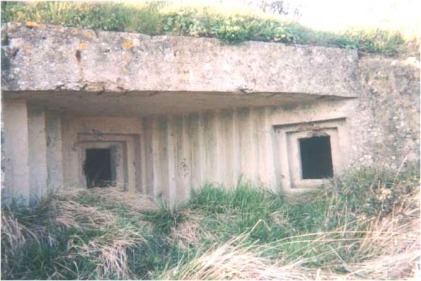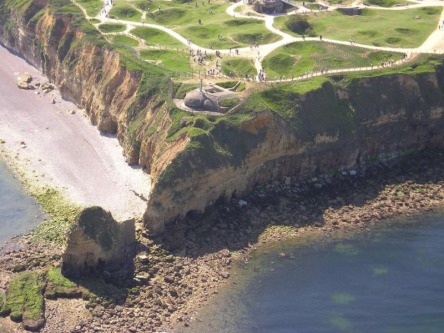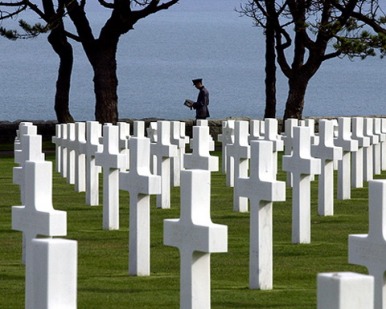Omaha Beach
Until June 6th 1944, Omaha was the name of a small town in Nebraska. Since that fateful date it has also come to represent the savage fighting that took place on June 6th, 1944 where a four mile stretch of sand in Normandy would became known as "Bloody Omaha"...
"Gentlemen, we are being killed on the beaches. Let us go inland and be killed" General Norman COTA

Boarding the assault craft
Omaha Beach was an obvious but necessary landing site...
As the dangers of assaulting Omaha Beach were clear to the Allied High Command, the seaborne landings were to be preceded by intensive air and naval bombardments just prior to touchdown.
All enemy gun positions should have been neutralized and the morale of the surviving enemy troops was expected to be shaken if not broken by the ferocity of these bombardments.
And the men who were to land on these 7000 yards of beach, the untested 29th Infantry Division in the west alongside the experienced 1st Infantry Division in the east, were expected to have few problems.
The initial assault waves consisting of amphibious tanks and combat engineer teams were to have cleared the beach obstacles and the following infantry were to proceed inland unhindered.
But the plan did not work out...
As the dangers of assaulting Omaha Beach were clear to the Allied High Command, the seaborne landings were to be preceded by intensive air and naval bombardments just prior to touchdown.
All enemy gun positions should have been neutralized and the morale of the surviving enemy troops was expected to be shaken if not broken by the ferocity of these bombardments.
And the men who were to land on these 7000 yards of beach, the untested 29th Infantry Division in the west alongside the experienced 1st Infantry Division in the east, were expected to have few problems.
The initial assault waves consisting of amphibious tanks and combat engineer teams were to have cleared the beach obstacles and the following infantry were to proceed inland unhindered.
But the plan did not work out...
"We must stop the enemy in the water and destroy all his equipment while it is still afloat"
Field Marshal Erwin ROMMEL

German bunker on the tableland in Saint Laurent sur mer
How were the German defenses organized on Omaha Beach ?
Were all the enemy gun and troop dispositions as well known to the Allies as they thought ?
When was the critical moment and could the invasion have failed ?
How did the American forces eventually avoid a complete military disaster on Omaha Beach ?
These are among the questions that will be answered on your tour of the beach !
The assault at Pointe-du-Hoc

The German range finding post on top of the Pointe du Hoc
Stormed in the morning of June 6th 1944 by 225 US Army Rangers, Pointe-du-Hoc was a strategic point for the German defenses on the Normandy coast.
It was highly necessary to neutralize that enemy position considering the guns there were able to fire on Utah Beach and Omaha Beach. Created in 1942 and trained initially by British commandos, the Rangers were assigned to scale 100 foot high cliffs to capture this German stronghold. Unfortunately, nasty surprises awaited them on D-Day morning and frustrated dangerously their plan...
Today, this impressive site presents the remains of the German artillery battery and the deep scars of fierce fights which took place here until June 8th...
It was highly necessary to neutralize that enemy position considering the guns there were able to fire on Utah Beach and Omaha Beach. Created in 1942 and trained initially by British commandos, the Rangers were assigned to scale 100 foot high cliffs to capture this German stronghold. Unfortunately, nasty surprises awaited them on D-Day morning and frustrated dangerously their plan...
Today, this impressive site presents the remains of the German artillery battery and the deep scars of fierce fights which took place here until June 8th...
Normandy American military cemetery and memorial

The Cemetery overlooking Omaha Beach
"Time will not dim the glory of their deeds"
General of the Armies John J.Pershing
The American military cemetery at Colleville Sur Mer contains the remains of nearly 10,000 US servicemen who died during the Normandy campaign. It overlooks the left flank of Sector "Easy Red " the bloodiest sector on Omaha Beach...
The American Battle Monuments Commission operates and maintains this permanent WWII cemetery and memorial here in Normandy where the United States of America has been given a perpetual concession over this land.
Among the burials at the cemetery are the recipients of 3 Medals of Honor :
Brigadier Theodore Roosevelt Junior, awarded for decisive leadership on Utah Beach on D-Day.
Technical Sergeant Frank D. Peregory, awarded for selfless action in Grandcamps Maisy on June 8th 1944.
First Lieutenant Jimmie W. Monteith Junior, awarded for decisive action on Omaha Beach on D-day.
General of the Armies John J.Pershing
The American military cemetery at Colleville Sur Mer contains the remains of nearly 10,000 US servicemen who died during the Normandy campaign. It overlooks the left flank of Sector "Easy Red " the bloodiest sector on Omaha Beach...
The American Battle Monuments Commission operates and maintains this permanent WWII cemetery and memorial here in Normandy where the United States of America has been given a perpetual concession over this land.
Among the burials at the cemetery are the recipients of 3 Medals of Honor :
Brigadier Theodore Roosevelt Junior, awarded for decisive leadership on Utah Beach on D-Day.
Technical Sergeant Frank D. Peregory, awarded for selfless action in Grandcamps Maisy on June 8th 1944.
First Lieutenant Jimmie W. Monteith Junior, awarded for decisive action on Omaha Beach on D-day.